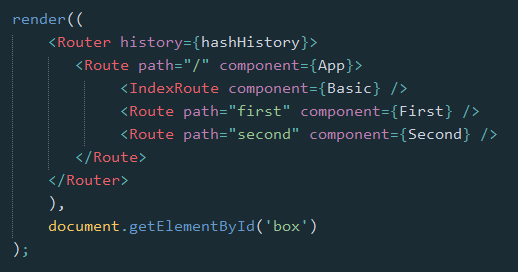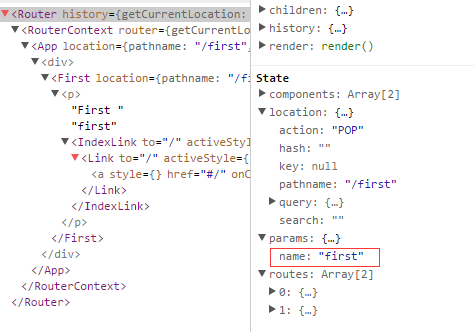React Router基础使用
React是个技术栈,单单使用React很难构建复杂的Web应用程序,很多情况下我们需要引入其他相关的技术
React Router是React的路由库,保持相关页面部件与URL间的同步
下面就来简单介绍其基础使用,更全面的可参考 指南
1. 它看起来像是这样
在页面文件中

在外部脚本文件中


2. 库的引入
React Router库的引入,有两种方式
2.1 浏览器直接引入
可以引用 这里 的浏览器版本,或者下载之后引入
然后就可以直接使用 ReactRouter 这个对象了,我们可能会使用到其中的几个属性
let {Router, Route, IndexRoute, Redirect, IndexRedirect, Link, IndexLink, hashHistory, browserHistory} = ReactRouter;
2.2 npm 安装,通过构建工具编译引入
npm install --save react-router
安装好路由库之后,在脚本文件中引入相关属性
import {Router, Route, IndexRoute, Redirect, IndexRedirect, Link, IndexLink, hashHistory, browserHistory} from 'react-router';
因浏览器目前还不能支持import与export命令,且babel工具不会将require命令编译,所以我们还得需要如Webpack等构建工具编译引入
库引入之后,在ReactDOM的render方法中,就可以使用相关的组件了
3. 路由简单使用
最基本的,通过URL判断进入哪个页面(组件部件)

class First extends Component {
constructor(props) {
super(props);
}
render() {
return <p>First</p>
}
}
class Second extends Component {
constructor(props) {
super(props);
}
render() {
return <p>Second</p>
}
}
class App extends Component {
constructor(props) {
super(props);
}
render() {
return <div></div>
}
}
render((
<Router history={hashHistory}>
<Route path="/" component={App} />
<Route path="first" component={First} />
<Route path="second" component={Second} />
</Router>
),
document.getElementById('box')
);
首先,Router是一个容器,history属性定义了是用何种方式处理页面的URL
有三种:
- browserHistory:通过URL的变化改变路由,是推荐的一种方式,但是需要在服务器端需要做一些配置(窝目前还不知怎么配)
- hashHistory:通过#/ ,其实就像是单页面应用中常见的hashbang方式,example.com/#/path/path.. (使用简单,这里暂且就用这种方式)
- createMemoryHistory:Memory history 并不会从地址栏中操作或是读取,它能够帮助我们完成服务器端的渲染,我们得手动创建history对象
然后,在容器中使用Route组件定义各个路由,通过path指定路径(可以看到,是不区分大小写的),通过component指定该路径使用的组件
也可以直接在Router容器上直接用routes属性定义各个路由,如
let routes =
<div>
<Route path="/" component={App} />
<Route path="first" component={First} />
<Route path="second" component={Second} />
</div>; render(<Router routes={routes} history={hashHistory}></Router>, document.getElementById('box'));
需要注意的是{routes}中只能有一个父级,所以这里加了<div>标签
另外,路由Route也可以嵌套,在上面的例子中,嵌套起来可能更符合实际情况
需要注意的是,这里的App在父级,为了获取子级的First与Second组件,需要在App组件中添加 this.props.children 获取
class App extends Component {
constructor(props) {
super(props);
}
render() {
return <div>{this.props.children}</div>
}
}
render((
<Router history={hashHistory}>
<Route path="/" component={App}>
<Route path="first" component={First} />
<Route path="second" component={Second} />
</Route>
</Router>
),
document.getElementById('box')
);
同样的,可以直接在Router中用routes属性定义路由
let routes =
<Route path="/" component={App}>
<Route path="first" component={First} />
<Route path="second" component={Second} />
</Route>; render(<Router routes={routes} history={hashHistory}></Router>, document.getElementById('box'));
4. 路由的其他组件
除了基本的Route之外,IndexRoute、Redirect、IndexRedirect、Link、IndexLink等,顾名思义
- IndexRoute: 在主页面会用到,如上个例子中,在路径"/"下我们看到的是空白页面,可以添加默认的页面组件用于导航
- Link: 可以认为它是<a>标签在React中的实现,使用to属性定义路径,还可以通过activeClass或activeStyle定义active的样式
- IndexLink: 类似Link,推荐用来定义指向主页面的链接,当然也可以随意定义

class First extends Component {
constructor(props) {
super(props);
}
render() {
return (
<p>First
<IndexLink to="/" activeStyle={{color: 'red'}}>Basic</IndexLink>
</p>
)
}
}
class Second extends Component {
constructor(props) {
super(props);
}
render() {
return <p>Second</p>
}
}
class Basic extends Component {
constructor(props) {
super(props);
}
render() {
return (
<ul role="nav">
<li><IndexLink to="/" activeStyle={{color: 'red'}}>Basic</IndexLink></li>
<li><Link to="/first" activeStyle={{color: 'red'}}>First</Link></li>
<li><Link to="/Second" activeClass="active">Second</Link></li>
</ul>
)
}
}
class App extends Component {
constructor(props) {
super(props);
}
render() {
return <div>
{this.props.children}
</div>
}
}
render((
<Router history={hashHistory}>
<Route path="/" component={App}>
<IndexRoute component={Basic} />
<Route path="first" component={First} />
<Route path="second" component={Second} />
</Route>
</Router>
),
document.getElementById('box')
);
- Redirect: 从from路径重定向到to路径
- IndexRedirect: 在主页面,直接重定向到to路径

render((
<Router history={hashHistory}>
<Route path="/" component={App}>
<IndexRoute component={Basic} />
<IndexRedirect to="first" />
<Redirect from="second" to="first" />
<Route path="first" component={First} />
<Route path="second" component={Second} />
</Route>
</Router>
),
document.getElementById('box')
);
5. 路由的path规则
path定义的路由的路径,在hashHistory中,它的主页路径是#/
自定义Route路由通过与父Route的path进行合并,在与主页路径合并,得到最终的路径
- :paramName 匹配 URL 的一个部分,直到遇到下一个/、?、#
- () 表示URL的这个部分是可选的
- * 匹配任意字符(非贪婪模式),直到模式里面的下一个字符为止
- ** 匹配任意字符(贪婪模式),直到下一个/、?、#为止
<Route path="/hello/:name"> // 匹配 /hello/michael 和 /hello/ryan
<Route path="/hello(/:name)"> // 匹配 /hello, /hello/michael, 和 /hello/ryan
<Route path="/files/*.*"> // 匹配 /files/hello.jpg 和 /files/hello.html
<Route path="/**/*.jpg"> // 匹配 /files/hello.jpg 和 /files/path/to/file.jpg
而:name可以通过 this.props.params 中取到
class First extends Component {
constructor(props) {
super(props);
}
render() {
return (
<p>First {this.props.params.name}
<IndexLink to="/" activeStyle={{color: 'red'}}>Basic</IndexLink>
</p>
)
}
}
.
.
<Route path="/:name" component={First} />

通过React Dev Tool也可以看到组件的相关数据

6. 路由的onEnter、onLeave钩子
在路由的跳转中,我们可能需要在进入页面或离开页面的时候做一些特殊操作,Route 通过 onEnter 与 onLeave 定义了这两个行为

<Route path="first" component={First} onEnter={(nextState, replace) => {
console.log(nextState);
alert('onEnter');
// replace('second');
}} onLeave={() => {
alert('onLeave');
}}/>
如上,带两个参数,通过 replace 可以更新路径,把注释去掉后,进入"/first"时立马跳转值"/second",这在检测登录时应该比较有用

更多的使用参见 指南
React Router基础使用的更多相关文章
- React Router基础教程
React是个技术栈,单单使用React很难构建复杂的Web应用程序,很多情况下我们需要引入其他相关的技术 React Router是React的路由库,保持相关页面部件与URL间的同步 下面就来简单 ...
- React入门---基础知识-大纲-1
-----------------在慕课网学习react入门笔记-------------- ---------博主边学边记录,手把手进行学习及记录---------- --------------- ...
- React Router教程
React Router教程 React项目的可用的路由库是React-Router,当然这也是官方支持的.它也分为: react-router 核心组件 react-router-dom 应用于浏览 ...
- React Router API文档
React Router API文档 一.<BrowserRouter> 使用HTML5历史记录API(pushState,replaceState和popstate事件)的<Rou ...
- React Router 用法
React Router 用法 一.DEMO import React from "react"; import { HashRouter as Router, Route, Li ...
- react router @4 和 vue路由 详解(全)
react router @4 和 vue路由 本文大纲: 1.vue路由基础和使用 2.react-router @4用法 3.什么是包容性路由?什么是排他性路由? 4.react路由有两个重要的属 ...
- React Router学习
React Router教程 本教程引用马伦老师的的教程 React项目的可用的路由库是React-Router,当然这也是官方支持的.它也分为: react-router 核心组件 react-ro ...
- [Web 前端] React Router v4 入坑指南
cp from : https://www.jianshu.com/p/6a45e2dfc9d9 万恶的根源 距离React Router v4 正式发布也已经过去三个月了,这周把一个React的架子 ...
- React:快速上手(6)——掌握React Router
React:快速上手(6)——掌握React Router 引入Router 安装 npm install react-router-dom 基础组件 React Router中有三种类型的组件:路由 ...
随机推荐
- javascript中的原型继承
在Javascript面向对象编程中,原型继承不仅是一个重点也是一个不容易掌握的点.在本文中,我们将对Javascript中的原型继承进行一些探索. 基本形式 我们先来看下面一段代码: <cod ...
- a标签的target的四个值
特殊的目标 有 4 个保留的目标名称用作特殊的文档重定向操作: _blank 浏览器总在一个新打开.未命名的窗口中载入目标文档. _self 这个目标的值对所有没有指定目标的 <a> 标签 ...
- Centos rsync文件同步配置
一.服务器端配置: # yum -y install xinetd CentOS默认已经安装了rsync 服务.. 输入 rsync 命令可查看是否安装. # vi /etc/xinetd.d ...
- MySQL 5.5.x配置文件详解
MySQL 5.5.x my.cnf参数配置优化详解 一直有耳闻MySQL5.5的性能非常NB,所以近期打算测试一下,方便的时候就把bbs.kaoyan.com升级到这个版本的数据库.今天正好看到一篇 ...
- dedecms标签使用
关键描述调用标签: <meta name="keywords" content="{dede:field name='keywords'/}">&l ...
- HDU 4169 UVALive 5741 Wealthy Family
树形背包.DP递推的思路很简单.... 但是由于节点有15万个,先不论空间复杂度,这样开dp数组 dp[150000+10][300+10],如果初始化是memset(dp,-1,sizeof dp) ...
- NSDateFormatter调整时间格式的代码
NSDateFormatter调整时间格式的代码 在开发iOS程序时,有时候需要将时间格式调整成自己希望的格式,这个时候我们可以用NSDateFormatter类来处理.例如://实例化一个NSDat ...
- 【转】20条Linux命令面试问答
问:1 如何查看当前的Linux服务器的运行级别? 答: ‘who -r’ 和 ‘runlevel’ 命令可以用来查看当前的Linux服务器的运行级别. 问:2 如何查看Linux的默认网关? 答: ...
- VB.Net隐式转换和显式转换的方法(转)
VB.Net隐式转换和显式转换的方法(转) “隐式转换”不需要源代码中的任何特殊语法.在下面的示例中,在将 k 的值赋给 q 之前,Visual Basic 将该值隐式转换成单精度浮点值. Dim ...
- FUNCTION CALL STACK FRAME
function call stack frame 两个寄存器 esp 栈顶指针寄存器,指向调用栈的栈顶(始终指向,意味着栈分配到哪里了,从当前栈往高地址是已经分配了的) ebp 基址指针寄存器,指向 ...
